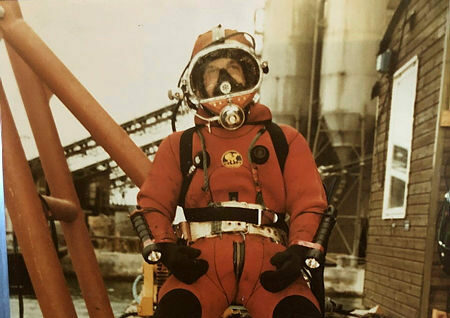Complaints about drilling during the search for the deceased

On March 31, 1980, the Edda platform completed inspection by divers and cleared by DNV as ready for drilling operations. [REMOVE]Fotnote: https://media.digitalarkivet.no/view/105509/446. On the same day, a total of 13 bodies were recovered from the seabed. Divers complained that drilling mud and chemicals were being released while the search for the deceased was ongoing.
Cleanup and the search for the deceased at the Ekofisk field continued until mid-May in 1980. Five diving boats were involved in the operation. Divers swam among structures and wreckage on the seabed, facing risks of getting stuck or having objects fall on them. Wigulf Schjøll, who dived from the Seaway Falcon boat, mentioned that Phillips was eager to commence production:
This might have had something to do with the American approach, where production and earnings came before everything. They wanted to drill, and therefore, they pumped out mud, resulting in minimal visibility during our dives.
Arne Jentoft, representing the organized divers in the Norwegian Union of Oil and Petrochemical Workers (NOPEF), prepared a report on the incidents. The report was sent to the Ministry of Trade and Shipping, the Maritime Directorate, and other authorities. The Norwegian Petroleum Directorate was tasked with investigating the incident[REMOVE]Fotnote: From Jan 1st 2024, it known as the Norwegian Offshore Directorate.
The report put forward, criticized Phillips Petroleum, among other things, for giving conflicting instructions. This particularly concerned the coordinator for the diving vessels at the accident site. Over VHF radio, it was claimed that all vessels were engaged in the search for the deceased. Simultaneously, the internal satellite communication at Ekofisk indicated that the divers should continue inspections to expedite the return of the Edda to production as quickly as possible.
Read the full report from NOPEF regarding the complaint about the discharge of drilling mud and chemicals here:
Phillips Petroleum apologizes for the incident.
Phillips Petroleum prepared a summary of the activities around Edda and Alexander L. Kielland after the accident. Here, Phillips Petroleum claims that when the accident occurred, production on Edda was halted for safety reasons. They also claimed that it was necessary to control the pressure in a well being drilled. During this operation, a valve was mistakenly opened, leading to a discharge into the sea.
According to Phillips Petroleum the discharge of drilling mud was an accident and not related to the start of production. They also issued an apology for the incident:
We deeply regret the concern caused by the unintended dumping of mud and greatly appreciate the excellent work done by the divers.
You can read Phillips’ explanation of the incident with a summary of the activities for the search around Edda and Alexander L. Kielland after the accident here:
Therefore, the Norwegian Petroleum Directorate did not find grounds to pursue the case further. Their conclusion of the investigation was communicated to NOPEF in a letter dated January 23rd, 1981, which can be read here:
https://media.digitalarkivet.no/view/112053/222
From the diver’s logs, poor visibility and the presence of mud is reported over the span of several days:
On April 4th, divers Gundersen and A. Jentoft on the Seaway Falcon reported that there was too much mud in the water:
On April 6th, divers Jacobsen and Gylseth had to abort a dive due to poor visibility:
Divers on Wildrake also report poor visibility during dives on various dates:
Was it possible to find more?
Some have questioned whether the mud settled over bodies, preventing their discovery. One of the divers who participated in the search in 1980 says this was not the case.
The drilling mud colored the sea and caused poor visibility. It was like diving in milk, but it didn’t settle on the bottom. The sea had strong currents that quickly carried the mud away, so the seabed remained clean. However, those same currents might have carried away bodies that weren’t discovered due to the poor visibility. (Yngve Tveit, at the Kielland gathering 31.08.2023.)
Read reports and diver logs from the field cleanup here:
arrow_backInitial investigations of the wreckage after the rig was towed ashoreFirst righting attemptarrow_forward